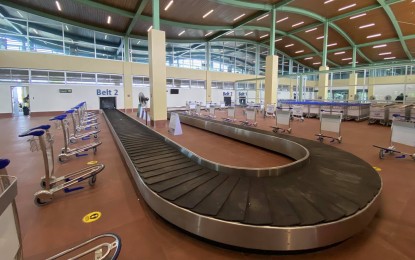
BOHOL-PANGLAO AIRPORT. The baggage recovery area of the Bohol-Panglao Airport is seen in this undated photo Central Visayas economic planners has put premium on an ambitious airport development program in Central Visayas in 2023, which is seen to increase connectivity and socio-economic activity. (Photo courtesy of Alodia Gosiengfiao's Facebook page)
CEBU CITY – Economic planners in Central Visayas have focused more on airport, seaport, and connectivity development projects worth over PHP130 billion in 2023.
The Regional Development Council (RDC)-Central Visayas 3rd quarter report showed that these infrastructure projects are related to connectivity and transportation, the completion of which is expected to boost economic activities and provide more job opportunities for over 8 million residents of the region.
According to the RDC-7 quarterly report, the Philippine government’s investments in infrastructure developments put more concentration on transportation connectivity and airport development programs.
As the National Economic and Development Authority (NEDA) Board approved the PHP4.5-billion expansion of the Bohol-Panglao International Airport, officials in Negros Oriental boasted of their New Dumaguete Airport in Bacong town.
The project’s PHP17.05-billion fund from the Philippine government through Official Development Assistance from the NEDA, was used to fund site acquisition by the Bacong municipality, through a memorandum of agreement with the Department of Transportation (DOTr).
The Cang-alwang Airport Development is also seen to boost the local economy of the small island province of Siquijor.
The PHP550-million project cost is divided into two – PHP450 million for civil works that will implemented by the Department of Public Works and Highways and PHP100 million for site acquisition undertaken by the provincial government of Siquijor.
In Cebu, the provincial government, under Gov. Gwendolyn Garcia, is engaged in massive airport development, showcasing Sta. Fe town airstrip on Bantayan Island and the Camotes Island Airport.
In 2021, the Department of Budget and Management released to the DOTr PHP265 million in funding for the Camotes Island airport construction while PHP154 million was for the runway expansion for the Bantayan airport project.
Once fully operational, the Camotes airport, which sits on a province-owned lot that has a 1.8-kilometer airstrip, will accommodate small private planes that can carry about 70 to 80 passengers at a time.
The Camotes airport will also cut travel time as boat rides here usually take two to three hours from the capital city.
In 2018, the authority to manage the airport in Bantayan Island transferred from the Civil Aviation Authority of the Philippines (CAAP) to the Mactan Cebu International Airport Authority (MCIAA).
Enhancing inter-connectivity
Kenneth Cobonpue, RDC-7 co-chair, said Cebu’s three major infrastructure development programs include the ongoing construction of the PHP16.3- billion Cebu Bus Rapid Transit, a first of its kind in the country and considered a major breakthrough in local transportation that will benefit Cebu City residents.
Cobonpue said the BRT project’s package 1 involves the construction of passenger terminals and dedicated lanes along the Osmeña Boulevard and a portion of P. del Rosario St. and Natalio Bacalso Ave.
Cebu BRT project manager, Norvin Imbong, said the project proponents announced at the Cebu City Mobility Summit 2022 at the Seda Hotel Ayala here on Sept. 26 that they are aiming to launch partial operations within 2023.
“The full operation of the Cebu BRT will be in the second quarter of 2025,” Imbong said.
To ease traffic in Metro Cebu thoroughfares, the Department of Public Works and Highways (DPWH) is overseeing the construction of an almost 60-kilometer Metro Cebu Expressway with a total indicative project cost of PHP94.07 billion.
The RDC-7 report said the first expressway project in Metro Cebu which traverses the mountain areas from Naga City to Danao City is now on completion for its 6th and 7th phases worth PHP154.4 million.
The DPWH-7 project status report said Segment 1 comprising the 25.20-kilometer Minglanilla to Cebu City and Mandaue-Consolacion boundary as well as the remaining 4.18-kilometer portion of Segment 3B will be implemented through public-private partnership (PPP).
The 23.36-kilometer Mandaue-Consolacion boundary up to Danao City under Segment 2 will be considered for future expansion is this portion is yet to be submitted to NEDA for approval.
The 4.20-kilometer stretch of Segment 3A along the Naga City-Minglanilla bounder is an ongoing project of the DPWH in the region.
“Metro Cebu Expressway will enhance seamless urban inter-modal transport system and will boost activity in the economic-tourism corridors,” Cobonpue said.
In Cebu, the civil works for the PHP9.9 billion New Cebu International Container Port project will soon start.
However, the RDC-7 report said the DOTr is yet to request the NEDA-Investment Coordination Committee for approval for the increase in project cost and extension of loan validity as well as project implementation period.
In Bohol, the construction of the Panglao-Tagbilaran City Offshore Bridge worth PHP6.9 billion has been approved by the NEDA-ICC but the RDC-7 Journal said another feasibility study has been undertaken through a grant from the Chinese government. (PNA)
